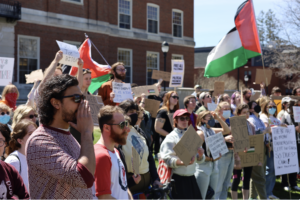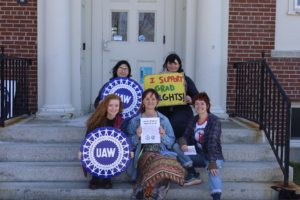University of Maine history professor Liam Riordan gave this week’s lecture as part of The Socialist and Marxist Studies Series, which has happened almost every week at UMaine since 1988. The series is also coached by Maine Peace Action Committee, which is mainly a student group through the Division of Student Affairs, and also receives support from the College of Liberal Arts and Sciences. Riordan teaches in the history department at UMaine with a specialization in American history and Revolutionary history from 1760-1830. Riordan’s lecture was titled, “The ‘Problem’ of Blackness in the Revolutionary United States.”
“Liam [Riordan] is the strongest promoter of humanity on campus and throughout the community,” Doug Allen, a professor of philosophy, said. This specific lecture is co-sponsored by the Office of Multicultural Student Life and the Black Student Union as part of Black History Month.
Riordan began his lecture by explaining the quotations around the word “Blackness” in the title of his opening slide.
“There has long been a convention of historical scholarship in wake of publications by David Brion Davis to recognize that slavery became a problem in the western world in the age of the Atlantic revolutions through the eighteenth and nineteenth centuries,” he said. “And then there is also a second and more troubling meaning. We also have to focus on the problem that presence of free african americans in revolution had created for Republicans.”
He then began talking about popular sovereignty, which is what the United States is based on. “This means that power comes from the people, so then, if there were African Americans that were free, it raises the question as to what their status as citizens were in this revolutionary United States?”
Riordan also gave a talk recently at the Portland Museum of Art titled, “Model Citizens: Art and Identity in the US 1770-1830.”
“This exhibit opened up our thinking of what the place of being a citizen and family identity was and how it relates to the New United States by striking absence in the curator exhibit. All images in this exhibit were white people, and we wanted to call attention to this,” Riordan said.
Riordan then turned this into a conversation with the audience, asking them what they thought about the most widespread images of people of African descent in early America. Many contributed their thoughts, but the overall consensus from the group was that the images displayed them almost always as slaves, servants or in slave advertisements in newspapers.
As the talk went on, Riordan spoke about a woman named Flora, who died in 1796. Her silhouette is on display at the Stratford Historical Society in Connecticut. Riordan talked about how the silhouette was the cutting edge of a new style of visual presentations in its time, as it defined people more than a normal painting would have. He also showed silhouettes of a white family, and then showed Flora’s image. “This silhouette of Flora also records centrality of slavery to African Americans’ experience, which was created to accompany Flora’s bill of sale from one Connecticut family to another Connecticut family.”
Later on in the discussion, Riordan brought back the discussion of Flora when he was discussing Gradual Emancipation. “It [Gradual Emancipation] did not free a single person on the day that it became a law. It said that children born to enslaved parents after that date would be free after they turn 21.”
The talk wrapped up with the discussion about the American Revolution and what it meant for slavery.
“We know that this broad era during the 18th century began to raise issues that questioned the validity of such radical human inequality. The 18th century was a period of accelerated capitalistic development and discussions on whether or not slavery could be a modern and efficient way to run society,” Riordan said.
Riordan’s talk was eloquent, informative and very fitting for the events and topics throughout Black History Month. The next talk titled, “Better Dead Than Red: The History of Red-Baiting in the United States” by Nathan Godfried, a professor of history, will take place on Feb. 22.







